
|
|
Journal: Whitby Psych
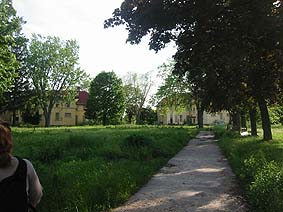
|
| The overgrown grounds of Whitby Psychiatric Hospital. |
Whitby Psychiatric Hospital (June 2003): Although we were well aware that we wouldn't be breaking any new ground by visiting the Toronto area's most popular abandoned asylum, eventually Scumbone and I found ourselves unable to resist the complex's siren song any longer. Driving out to the eastern suburbs late one Sunday afternoon, we stashed Scumbone's car in a nearby subdivision and wandered over to the collection of 50-odd abandoned buildings to try our luck.
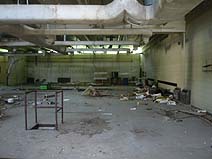 |
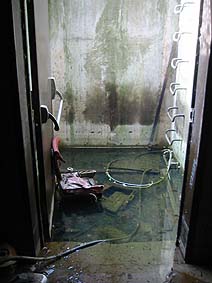 |
| The laundry building's main floor and basement. |
Luck was with us. The place had obviously not been boarded up anytime recently and we were able to find easy entrances to almost every building we turned our attention to, which was basically every building we had time for. Aside from a few small sheds, pretty much every building in the complex is interesting enough that it would make an impressive find if discovered on its own, though it's a shame that they're all thoroughly looted, smashed and vandalized.
After exploring the thoroughly debris-strewn laundry building — from its dark and flooded basement to its bright and sunny rooftop — we moved on to the huge powerhouse building, and here we encountered our first fellow tourists, a gang of three girls and one guy.
"Come here often?" I asked.
"Only when we're really bored," one of the girls replied as she kicked a wooden cabinet out of her way contemptuously.
Sensing that they weren't on the same awed wavelength as us, Scumbone and I occupied ourselves elsewhere in an attempt to let them "play through", though they persisted in yelling out and asking us for directions. Heading into the basement, Scumbone and I toured a short section of steam tunnels that came to an end at an unpassable cinder block wall, and then returned upstairs to visit the rest of the mammoth powerhouse, marvelling at how its machinery and peeling walls looked in the evening sunlight pouring in through the windows. Heading to the main engine room, we climbed up onto the mammoth machines and then strolled along the catwalks at the top of the room. We figured out how to access the neighbouring smokestack from inside the powerhouse, but neither of us was up for the climb up through the old incinerator.
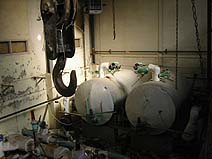 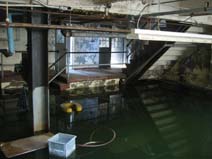 |
| The powerhouse was the most luscious looking building we visited. |
Leaving the powerhouse, we moved on to explore an old staff building that had once suffered through a fire, some sort of community centre building, and a men's residence, each time finding access extremely straightforward. Getting in involved a little bit of crawling or climbing at the most. We figured if security showed up we could just point at the open window or door we'd climbed through and say "C'mon, how could we resist?"
 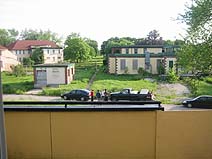 |
| Accessing the various cottages was not very tricky; from this residence, we spotted another group of explorers who weren't going out of their way to be stealthy. |
Besides that, if security was going to catch anyone, they'd almost certainly catch one of the other groups first. From the second floor of the men's residence, we spotted a second posse of fellow explorers, this time a group of four guys in their early 20s, returning to a small squadron of cars and trucks they'd parked right in the middle of the complex. We came out onto the veranda to try to discreetly get their attention and see if they were anyone we knew, but they were so loud and oblivious that they didn't even notice us as they put away their large Maglites and drove away.
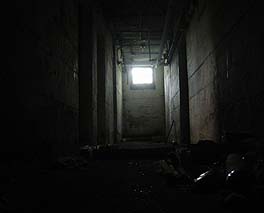 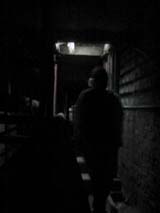 |
| In the basement of the residence, we stumbled upon the main branch of the tunnel system and headed in. |
Heading down to the unlit basement and crawlspace beneath the men's residence, Scumbone and I were delighted to stumble upon the main network of steam tunnels that crisscross the hospital's entire grounds, thoughtfully dug out by slaves *ahem* prisoners between 1913 and 1916. Strapping on our masks, we headed up one branch until we came to the basement of the beautiful kitchen building. We headed upstairs to examine the old signs, stoves and other odd appliances still strewn about the building, and then headed up to visit the mechanical room and roof before returning to the tunnels.
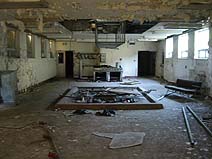 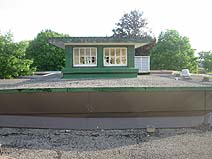 |
Emerging from the tunnels, we explored the beautiful kitchen
building from basement to roof. |
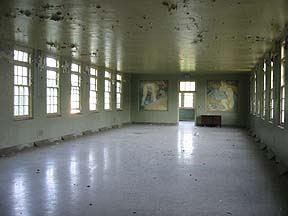
|
| Someone had recently had a wine tasting party in this infirmary solarium. |
Crawling under some low-hanging pipes and through some flimsy mesh barricades in the steam tunnels, we eventually came to the basement of the infirmary. Taking a ramp up from the basement to the infirmary's top floor, we came upon a beige hallway that looked relatively freshly painted (though it too had already begun to peel). After finding some false wooden walls that Scumbone deduced to be movie sets and sheets of instructions taped to the walls reading "do not paint passed (sic) this point", we concluded that much of this building had been painted for use as a movie set (apparently sometime since the place was visited by our comrades at UEC). Also up here, we found a large green room with paintings on the wall and broken wine bottles strewn about the floor. On the ground floor, we found a massive mountain of broken glass: it seemed that some enterprising vandal must have collected glass from all over the building and brought it to this central stockpile in order to destroy it all at once.
By now we were starting to think about calling it a day but, unable to find any open doors or windows we could use to exit the infirmary, we were obliged to head back into the steam tunnels in order to make our way back to a building with an outside exit. As we ventured back outside, peeled off our facemasks, and gratefully sucked in oxygen, we faced the greatest hazard of the day as swarms of very hungry mosquitos chased us off the grounds and back to the car.
Continue Back in Journal | Switch to Journal Index
|
|

